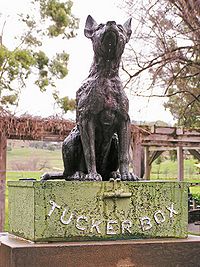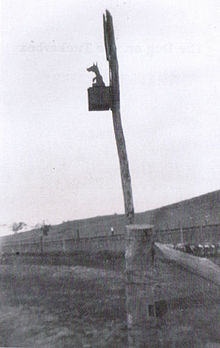| Revision as of 04:19, 27 July 2006 editGalactor213 (talk | contribs)1,125 edits Typo's are normally one word. This is an entire paragraph. Revert due to expected vandalism← Previous edit | Revision as of 06:18, 27 July 2006 edit undoMatilda (talk | contribs)Extended confirmed users22,816 edits Revert to revision 66088444 dated 2006-07-27 03:13:32 by AYArktos using popupsNext edit → | ||
| Line 12: | Line 12: | ||
| The Back to Gundagai Committee had chosen the Five Mile camping site rather than the Nine Mile Peg as a location for the monument on the basis that it was more convenient to the ] and closer to the town, thereby more beneficial to tourism.<ref name ="Butcher212-3"/> | The Back to Gundagai Committee had chosen the Five Mile camping site rather than the Nine Mile Peg as a location for the monument on the basis that it was more convenient to the ] and closer to the town, thereby more beneficial to tourism.<ref name ="Butcher212-3"/> | ||
| A nationwide competition was held to obtain the most suitable inscription for the monument. The chosen inscription on the base of the monument was written by ] of Sydney.<ref name ="Butcher212-3"/> It has been suggested that the inscription refers to a time before the appearance of the first poem in the 1850s when there was a lot of conflict in the Gundagai area and further south and west as settlers took over the traditional lands of the Wiradjuri, and overlanders moved large mobs of cattle to Adelaide and Melbourne.{{fact}}<!--note Butcher states about the inscription "travellers ... be reminded of our heroic pioneers when they read the inscription on the monument". If no source provided for the assertion by 4 August 2006 (a week from posting this comment) the assertion will be removed. AY Arktos --> The inscription says: |
A nationwide competition was held to obtain the most suitable inscription for the monument. The chosen inscription on the base of the monument was written by ] of Sydney.<ref name ="Butcher212-3"/> It has been suggested that the inscription refers to a time before the appearance of the first poem in the 1850s when there was a lot of conflict in the Gundagai area and further south and west as settlers took over the traditional lands of the Wiradjuri, and overlanders moved large mobs of cattle to Adelaide and Melbourne.{{fact}}<!--note Butcher states about the inscription "travellers ... be reminded of our heroic pioneers when they read the inscription on the monument". If no source provided for the assertion by 4 August 2006 (a week from posting this comment) the assertion will be removed. AY Arktos --> The inscription says: | ||
| :''Earth's self upholds this monument | :''Earth's self upholds this monument | ||
| Line 18: | Line 18: | ||
| :''When wooing was dangerous | :''When wooing was dangerous | ||
| :''And are now gathered unto her again.''" | :''And are now gathered unto her again.''" | ||
| Gundagai is well known for the image of a dog on a box. This symbolism is more recently based on a poem about a bullock waggon stuck in the mud near Gundagai pre gazettal of Gundagai as a town in 1838. This bullock waggon carried a load of flour for the European settlers. The flour had to come from the mill at Goulburn. There was a severe drought happening. The flour on the bogged bullock wagon was rifled while the bullock driver was in the nearby hotel and subsequently, the remaining flour was laced with arsenic. More flour was taken from the waggon by Aboriginal people with the end result being there were many deaths. The massacre was heard about in Sydney and was investigated, but no one was able to be held to account. For many years the event was told and retold and a dog figure, representing an aspect of Australian Aboriginal lore, was placed on a stick at the Nine Mile near where the massacre happened. A photo exists of this earlier Dog monument. The story was passed down among long-time Gundagai residents and is still spoken about in Gundagai today but for many years when it was mentioned, people were told not to speak about it. The story was also retold in a popular Australian poem by Jack Moses but from a different, perhaps less challenging, perspective which explained the lingering tale that just would not go away. The known disparity between, and debate about, whether the event happened at the Five Mile or Nine Mile is to do with this. There are archival records documentating this iconic and significant Australian cultural heritage. The Gundagai incident is independent of the Benalla one. The Benalla massacre (if it is the 'Faithfull Massacre)was the one that led to Gundagai being gazetted. I have copies of the original documents of the line of communication being put through to Melbourne after the Faithfull Massacre. The Coolac Massacre story is still well known in Gundagai but not spoken about publically. There is no original research required for the Coolac Massacre as that it happened has never been forgotten in this town. The first poems about the massacre appeared in the 1850s. The monument to the massacre was built in 1932 and that monument is identical to a major Indigenous Ancestral feature. The Gundagai Independent in about October 2005 has some content. The Coolac massacre is currently part of not yet completed archaeological surveying in that area as reported online on ABC News. NSW National Parks have been notified of where the massacre remains were put. This burial area from the 1830s was previously known to National Parks. NSWNP do not release all information they hold. The massacre is spoken of in Gundagai's verse and song, the 'Dog' being 'first man' in Aboriginal culture. There are other supporting documents such as Tindale's letters and others. ({{fact}}<!--very interesting but need some sources please; note this reads very much like an incident near present day Benalla on 11 April 1838 - were there two or is there confusion?-->(citation requested and comment inserted by AYArktos) There were many many massacres of Indigenous people in Australia. | |||
| An annual Dog on the Tuckerbox festival has been held each year since ], the 60th anniversary of the monument.<ref>Butcher, page 228</ref> In November ], the Annual Festival included a 2 day Snake Gully Cup Racing Carnival and festivities at the Dog on the Tuckerbox centre.<ref>http://gundagai.local-e.nsw.gov.au/events/pages/1034.html</ref> | An annual Dog on the Tuckerbox festival has been held each year since ], the 60th anniversary of the monument.<ref>Butcher, page 228</ref> In November ], the Annual Festival included a 2 day Snake Gully Cup Racing Carnival and festivities at the Dog on the Tuckerbox centre.<ref>http://gundagai.local-e.nsw.gov.au/events/pages/1034.html</ref> | ||
Revision as of 06:18, 27 July 2006


The Dog on the Tuckerbox is an Australian historical monument and tourist attraction, located at Snake Gully, five miles (8 km) from Gundagai, New South Wales. It was sculpted by local stonemason Frank Rusconi and was unveiled by the then Prime Minister of Australia Joseph Lyons on 28 November, 1932 as a tribute to pioneers.
A dog monument had been first erected at a site nine miles from Gundagai in 1926.
The statue was inspired by a bullock driver's poem, Bullocky Bill, written at a campsite near Gundagai under the pen name 'Bowyang Yorke', first printed in 1857. A later poem by Jack Moses was a cleaned up version of this poem and published in the 1920s. This poem was very popular and was the inspiration for the statue. Moses's poem, Nine Miles from Gundagai was first published in 1938, several years after the statue's unveiling. Jack O'Hagan's song, Where the Dog Sits on the Tuckerbox (5 miles from Gundagai) was published in 1937.
Frank Rusconi had suggested a memorial using the legend of the Dog on the Tuckerbox in 1928. However, in 1932 the proposal was taken up by the community. The 'Gundagai Independent' of 1932-08-11, wrote:
"A Monument should be erected at the Nine Mile peg dedicated to the pioneers and bullockies, who made the highway of today possible. And there should be an unveiling ceremony during 'Back to Gundagai Week'."
The Dog on the Tuckerbox monument was erected as part of 'Back to Gundagai' Week in 1932 and a large crowd "gathered to her again" to witness the unveiling by the Prime Minister. It was planned to donate money placed in the wishing well at the base of the monument to the Gundagai District Hospital. A souvenir shop was also opened nearby.
The Back to Gundagai Committee had chosen the Five Mile camping site rather than the Nine Mile Peg as a location for the monument on the basis that it was more convenient to the Hume Highway and closer to the town, thereby more beneficial to tourism.
A nationwide competition was held to obtain the most suitable inscription for the monument. The chosen inscription on the base of the monument was written by Brian Fitzpatrick of Sydney. It has been suggested that the inscription refers to a time before the appearance of the first poem in the 1850s when there was a lot of conflict in the Gundagai area and further south and west as settlers took over the traditional lands of the Wiradjuri, and overlanders moved large mobs of cattle to Adelaide and Melbourne. The inscription says:
- Earth's self upholds this monument
- To conquerors who won her,
- When wooing was dangerous
- And are now gathered unto her again."
An annual Dog on the Tuckerbox festival has been held each year since 1992, the 60th anniversary of the monument. In November 2005, the Annual Festival included a 2 day Snake Gully Cup Racing Carnival and festivities at the Dog on the Tuckerbox centre.
A food court style development opened nearby in 2006 with a KFC, Subway, McCafe, BP service station and Tuckerbox restaurant.
External link
- Dog on the Tuckerbox tribute page including the two poems that inspired the monument
References
- Scarff, L (1994). The Dog on the Tuckerbox: it's story. Kangaroo Press, Kenthurst, NSW. 0864176279
- ^ Butcher, C., (2002) Gundagai: A Track Winding Back, C. Butcher, publisher, pp 212-213.
- Butcher, page 228
- http://gundagai.local-e.nsw.gov.au/events/pages/1034.html